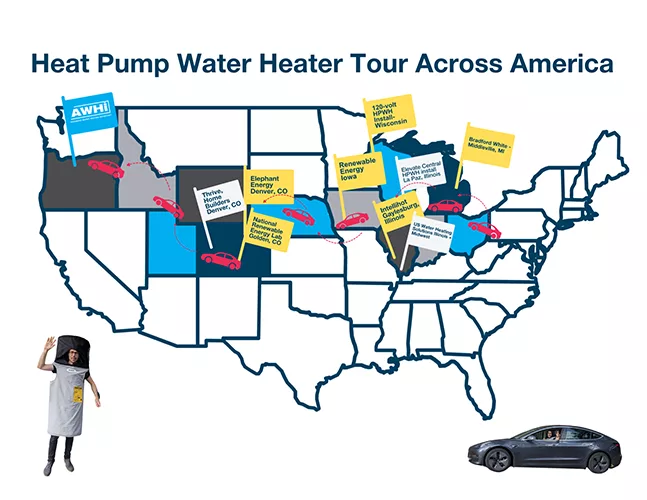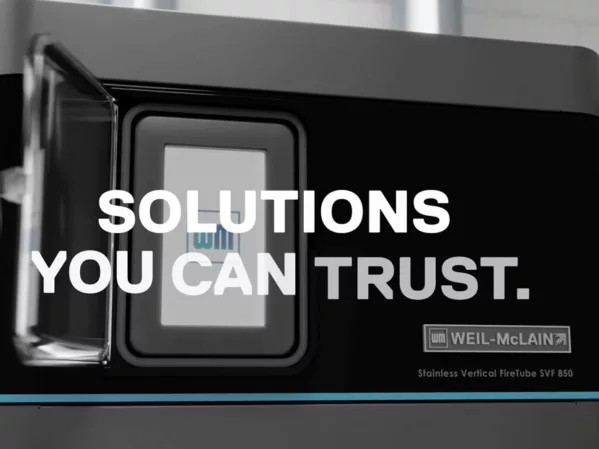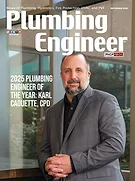Last year, I embarked on a cross-country tour of America to see the quiet revolution taking place in decarbonized water heating. I had the opportunity to visit factories that produce heat pump water heaters (HPWHs), installers who are training their staff to capture the oncoming tidal wave of installations, labs that are researching the latest innovation in decarbonized water heating, affordable housing locations that are working to provide low cost and clean water heating, and home builders who are installing heat pump water heaters in new abodes.
It was an awesome, amazing, incredible, insert-your-superlative-of-choice trip here. I, of course, brought my heat pump water heater costume as I interviewed lots of folks working on the cutting edge of saving the planet and helping people take better, cleaner, lower-cost showers.
Here are some of the highlights from my trip:
Visiting a heat pump water heater factory: My first stop was a journey up to Middleville, Michigan. Here, Bradford White Corp. has been making millions of water heaters for over a century (tinyurl.com/y4bdx923). Bradford White also has the distinction of being the only factory making heat pump water heaters in America.
While walking nearly three miles across the mammoth factory floor, I witnessed the pride and craftsmanship that goes into producing a great product from people who are truly invested in their workplace. I saw all the myriad steps that go into making an efficient water heater, from the sheets of metal coming into the factory to the heat pump water heaters coming out and everything in between.
Heat pump water heaters are still only a relatively small percentage of Bradford White’s sales (though national sales for all HPWHs grew 35% in 2023 (tinyurl.com/4enmes9a)), and I could see that reality at the factory where the gas and electric resistance water heaters had many more units coming down their respective lines.
But this is changing quickly and Bradford White and other manufacturers say their heat pump lines are ready to accommodate all the demand that’s being created as we seek to electrify and decarbonize water heating. I can’t wait to check out the factory again in five years to see how the heat pump line has scaled.
A Midwest contractor surfing the wave of heat pumps to a thriving business: For my next stop, I visited a large water heater installer and servicer who has created a thriving business model around heat pump water heaters — U.S. Water Heating Solutions (www.uswhpro.com). This company is based in Arlington Heights, Illinois, but provides service to 25 states nationally.
U.S. Water Heating Solutions both installs and fixes water heaters and has embraced heat pump water heaters in a big way. This, in turn, has led to lots of business, which is helping this company grow and expand as it rides the heat pump tidal wave into the future.
CEO Jim Eggert told me how his company views heat pump water heaters as an “innovative, technologically advanced product line” and wants to “grab a surfboard, jump in and catch this (heat pump) wave.”
They see heat pumps as the way of the future and are excited by the business opportunity of specializing in this equipment early. I also got to check out the company’s training lab at its headquarters in Illinois, where all types of water heating equipment are on display, including a whole row dedicated to HPWHs, which was really cool.
Commercial heat pump water heater stops: I also got to see two sites that are part of the movement in commercial heat pump water heaters.
First, I stopped in Chicago to see an apartment building called La Paz that has installed one of the first commercial HPWH systems in a cold climate in the country.
With multiple grants from various philanthropic sources, the team electrified all the apartments and converted the building’s gas water heaters to heat pumps. The team had to make adjustments along the way, which included adding more hot water storage and a split HPWH system. They aren’t shy about talking about the challenges of this project and have learned a lot about system design which they’ve incorporated into their other installations and other buildings.
The second commercial HPWH stop was to visit Intellihot, a manufacturer specializing in tankless commercial gas water heaters, but recognizes the momentum behind heat pumps. In fact, Intellihot makes a tankless heat pump water heater. Although there is a small tank in this unit, it doesn’t store potable water. Instead, Intellihot calls it a thermal battery and this smallish tank stores a superheated water/glycol mixture.
Best of all, the water heater uses CO2 for its refrigerant, which is natural and has a very low global warming potential.
National lab, home builder and a business built around electrification: To finish my trip, I stopped at three key groups that are transforming the water heating market towards heat pumps.
My first stop was at the National Renewable Energy Lab (NREL) in Golden, Colorado, where a lot of cutting-edge research is being done on heat pump water heaters. I chatted with researcher Bethany Sparn, who showed me around their integration lab. Here, NREL researchers experiment with how HPWHs and other electric appliances interact with the grid. They test the load-shifting capabilities of heat pump water heaters to see if the equipment can successfully operate at off-peak times without impacting homeowners.
They also were testing new 120-volt HPWHs that plug into a standard wall outlet. Bethany also talked to me about a recently funded project (tinyurl.com/bdh2svhn) to make 120-volt HPWHs even smaller so they can fit into tight spaces like closets in multifamily apartments.
Next up, I went to Thrive Home Builders in Denver, which is installing HPWHs in all its new homes. Thrive is responding to both local codes requiring pollution-free equipment for space and water heating, as well as customer demand for the most efficient homes on the market.
I toured one of Thrive’s homes and was impressed by the fact that the homebuilder was successfully able to incorporate the HPWH into a townhome; townhomes can have less space for an HPWH (which needs air space to extract heat from). Thrive designed their HPWHs into closets where they duct the cool air outdoors.
To finish my trip, I went to Elephant Energy, a Colorado-based climate tech startup that is helping homeowners electrify their homes. Elephant helps consumers create an electrification roadmap and then helps facilitate all steps of their journey to all-electric homes.
A big part of that journey includes getting a heat pump water heater and Elephant described its process of helping homeowners transition to HPWHs based on where their water heater is located and what type of existing water heater they have. Elephant coordinates the HPWHs installers who come and replace water heaters and helps consumers apply for rebates.
All in all, my HPWH Tour Across America was both fun, informative and inspiring. Innovation and market transformation in water heating are occurring across the United States thanks to the leadership of individuals and organizations coast to coast. Best of all, I got to tour these great sites wearing my heat pump water heater costume.
Check out a one-minute compilation video (tinyurl.com/4naazezk) of some heat pump dances I got to do with folks on my tour.






